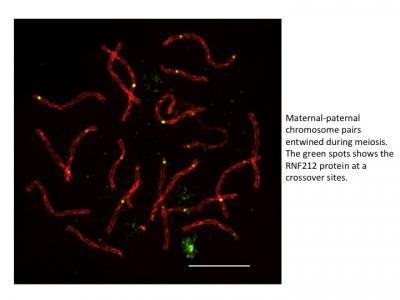Neil Hunter's laboratory in the UC Davis College of Biological Sciences has placed another piece in the puzzle of how sexual reproduction shuffles genes while making sure sperm and eggs get the right number of chromosomes.
The basis of sexual reproduction is that a fertilized egg gets half its chromosomes from each parent — sperm and eggs each contributing one partner in each pair of chromosomes. We humans have 23 pairs of 46 chromosomes: so our sperm or eggs have 23 chromosomes each.
Before we get to the sex part, though, those sperm and eggs have to be formed from regular body cells that contain twice as many chromosomes. That happens through a specialized type of cell division, meiosis.
During meiosis, the couples in each pair of chromosomes have to, well, couple by "crossing over" with each other. Each chromosome pair must become connected by at least one crossover so that when the couples separate, they are delivered to separate sperm or egg cells.
These crossovers also mean that chromosomes can exchange chunks of DNA with each other, shuffling the genetic deck for the next generation. But if too few crossovers are formed, gametes end up with the wrong number for chromosomes, a situation that can cause infertility, pregnancy miscarriage or chromosomal diseases such as Down Syndrome.
Large-scale studies of human genetics have shown that the number of crossovers formed during meiosis is under genetic control. Moreover, women that make more crossovers tend to have more children. One gene suggested to control crossover numbers in humans, called Rnf212, is the subject of a new study by UC Davis researchers lead by Professor Neil Hunter.

This shows chromosome pairs entwined during crossover, a key step in meiosis. Green spots show the location of RNF212, a protein now shown to be important in initiating and stabilizing crossovers.
(Photo Credit: Neil Hunter, UC Davis)
Hunter studies how crossovers form and chromosomes separate at the UC Davis Department of Microbiology & Molecular Genetics and the Comprehensive Cancer Center. In 2009, he was awarded an early career fellowship from the Howard Hughes Medical Institute.
Chromosome pairs entwined during meiosis. Green spots show the location of RNF212. (Neil Hunter/UC Davis)The latest paper from Hunter's lab, published Feb. 10 in Nature Genetics, shows that Rnf212 is essential for crossing-over in mammalian cells. Crossovers form by a process called homologous recombination, in which chromosomes are first broken and then repaired by coupling with a matching template chromosome. Although hundreds of recombination events are started in each cell, only one or two crossovers will form between any given pair of chromosomes.
"There isn't a special, predetermined site for a crossover. It can occur just about anywhere along a chromosome. But there has to be at least one and there always is," Hunter said.
In a series of experiments in mouse cells, graduate student April Reynolds, Hunter and colleagues found that the RNF212 protein defines where crossovers will occur by binding to just one or two recombination sites per chromosome where it triggers the accumulation of the protein machinery that actually carries out the cutting and splicing of DNA.
Mice that lacked the gene for RNF212 were sterile. Mice that had one working copy of the gene were fertile, but on careful examination there were fewer crossovers formed while sperm and eggs were being made than in normal mice, potentially reducing fertility. It's possible that this might be tied to some causes of infertility in humans.
It remains unclear how each pair of chromosomes always manages to crossover at least once. But Hunter says he is, "convinced that RNF212 holds the key to understanding this unique problem in chromosome biology."
Source: University of California - Davis